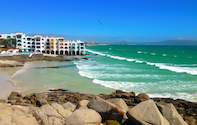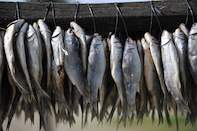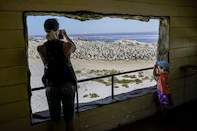Carrie Hampton took a trip up the West Coast of South Africa and found not only some stunning coastal and inland scenery, but amazing bird watching, peculiar things to eat, herbal teas, hand-made shoes and tasty wines.

The West Coast Regional Tourism Organisation launched their logo showing a searing sun, vast blue ocean and flower dotted plains and hills, roamed by a bushman. What it is trying to tell you is that the West Coast Region encompasses not only the seaboard, but the rolling Swartland hills, the lush Olifants River Valley and the Cederberg Mountains as well.
The enticing Langebaan Lagoon is well known to most Capetonians and it is undoubtedly the most charming warm water delight of the coast. Especially when the spring flowers cover the Postberg peninsula with brilliant brushstrokes of colour.
But I found another beach haven, The Blouwaterbaai Holiday Resort, just as you enter Saldanha. It consists of the Blue Bay Lodge with rooms and garden cottages, and privately owned beach houses not a stone's throw from the sand. The night vista glitters with lights from the iron ore jetty, which admittedly is not quite so pretty in daylight, but the proximity of sea and sand makes up for the unsightly harbour.
Try Bokkoms

Bokkoms are a typically west coast thing. I almost used the word 'delicacy' but as this suggests a dainty kind of food with a fineness of texture, I thought better of it. Only in Veldriff did I meet people who actually like bokkoms - dried and shrivelled silvery harders.
Rarely do the little fishing boats need to go out to sea - they catch enough of these slippery little fish in the mouth of the Berg River - but never, to my astonishment, manage to fulfill the demand.
Bird and Whale Watching

Sea birds are ever-present and never more so than at Lambert's Bay further up the coast. The colony of beautiful pale cream Cape Gannets, a short walk past the harbour onto the peninsula, is a sight to behold. There are thousands of pairs performing to each other, and the density of birds means that they must take off and land like a Harrier jump jet.
Their huge splayed feet can surely walk on water and their pointed grey beaks are positively menacing. Even though there are major plans to upgrade the viewing facilities, the existing fake-rock building offers a fantastic close to nature experience. Lambert's Bay also offers probably the best boat-based whale and dolphin watching in the Western Cape. The MTN's Whale Route marine biologist, Darden Lotz, says it is one of her very favourite places in the world.
For a fabulous wide and wild beach try Strandfontein, with views from every cliff top holiday cottage. Here too are great plans for expansion with a new hotel and holiday units in the pipeline. Inland from Strandfontein (there is no other way), to Vredendal, you will pass the Lutzville vineyards and Spruitdrif Wine Cellar, who both produce light wines perfect for seaside picnics.
Returning towards Cape Town on the N7, why not stop at Clanwilliam, not only for the dam and its watersports, but to buy top grade export quality Rooibos tea from the head office. Or a pair of handmade leather shoes from the Strassbergers veldskoen factory and a quick tour around the whirring, clunking workshop. They will make personalised shoes for the strangest of feet.
Enjoy a Detour

Instead of returning straight to Cape Town, take a detour via Porterville for a breath of mountain air. It seems that only paragliders visit this sleepy town at the foot of the Groot Winterhoek Mountains, and they congregate at the colourful bush pub on the old station platform.
At the Dasklip launch site, they leap off into spiralling thermals of warm air, to gain heights of over 9,000 feet enabling them to reach distances of over 100km. But I discovered an alternative activity in them thar hills. Hiking in the Groot Winterhoek Wilderness Area is a divine experience. The difference between a Wilderness and a Nature Reserve is that the former can only be designated as such if it is truly wild and untouched by man.
Winterhoek is certainly that, and you can walk wherever you please, although there are some recommended, yet unmarked trails. Visitors are limited in number, so on any one-day, you have approximately 100,000 hectares each to get lost in.
The west coast offers such a variety of experiences that it deserves your attention for several weekend breaks. Contact the individual tourist information offices for an enthusiastic response on where to go, what to see and where to stay.
By Carrie Hampton